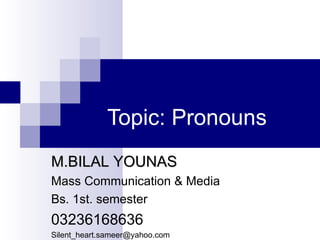Relative Clause
- 1. Topic: Pronouns M.BILAL YOUNAS Mass Communication & Media Bs. 1st. semester 03236168636 Silent_heart.sameer@yahoo.com
- 2. The pronoun is a word used in place of one or more nouns. It may stand for a person, place, thing, or idea. s Indefinite Pronouns Demonstrative Pronouns n oun anybody this ro nal P , mine each that P erso , my urs e yo either I, m , your, ers, none these you , her, h she it, its urs someone, one, etc. Interro those o ur, s, o , their , gative P ,u we them ronoun , s who s they their elf whom mys elf rs what you which whose
- 3. Personal pronouns ïŪ They replace nouns which refer directly to persons and are of two kinds, those functioning as subjects and those functioning as objects in sentences. The personal pronouns which function as subjects are I, you, he, she, it, we, and they while those which function as objects are me, you, him, her, it, us, and them.
- 4. Possessive pronouns ïŪ They are used to express possession. Singular Plural Mine Ours Yours Yours His Hers Theirs its
- 5. ïŪ The possessive pronouns cannot be used before nouns because they replace them. So, they can stand alone without the nouns. They are used to avoid repeating the nouns. ïŪ EXAMPLES: ïŪ My pen is like yours. ïŪ Their car moved before ours. ïŪ This book is mine. ïŪ Is that book yours?
- 6. Demonstrative pronouns ïŪ These point to the nouns they replace. Demonstrative pronouns are this, that (singular) these, and those (plural). ïŪ The demonstrative pronouns are used without the nouns. They point to the place of the person or thing that is referred to. âthisâ and âtheseâ refer to objects that are close to the speaker; âthatâ and âthoseâ refer to objects that are far away from the speaker. ïŪ Examples: ïŪ This is my book. ïŪ Those are his pens. ïŪ That is your desk.
- 7. Interrogative pronouns: ïŪ These pronouns are used to ask questions and they are who, whom, whose, what, and which. EXAMPLES ïŪ Who initiated the scheme? ïŪ Whom can we consult about the matter? ïŪ Whose is this bright idea? ïŪ What has been done for the unprivileged in society? ïŪ Which is the shortest route to the campus?
- 8. Indefinite pronouns ïŪ They are used to refer to people or things in a very general way. Among the common indefinite pronouns are someone, somebody, something, anyone, anybody, anything, everything, nobody, nothing, none, each, some, both, all, several, few, many, much, more, little, less, other, others, one, two, three, and so on.
- 9. EXAMPLES ïŪ Someone must have tampered with the lock. ïŪ Anybody who will not work to earn a living deserves to go hungry. ïŪ Everything that needs to be done has been done. ïŪ None among those involved wishes to make a complaint. ïŪ Several of us have applied for the scholarship. ïŪ Much needs to be done to improve conditions. ïŪ Others will be affected if you make a mistake. ïŪ Among many students, three have scored distinctions.
- 10. Reciprocal pronouns ïŪ They refer to two or more nouns in a reciprocal relationship. The two reciprocal pronouns are each other and one another. ïŪ All the staff members compete with one another for the annual awards. ïŪ These two friends do not trust each other.
- 11. Reflexive Pronouns ïŪ The reflexive pronouns are Singular Plural Myself Ourselves Yourself Yourselvs Himself Herself themselves Itself
- 12. Use of Reflexive Pronouns ïŪ The reflexive pronouns are used in the following cases: 1. They are used to show that the subject and the object are identical the same person or thing). In this case the reflexive pronoun usually follows the verb. Examples: I hit myself The child washed himself yesterday. 2. They are used to express emphasis. It is placed directly after the subject or at the end of the sentence. Examples: I myself sent the letter. She cooked the food herself. The student himself did the assingment. 3. They are sometimes preceded by the word âbyâ to mean âaloneâ or âwithout helpâ Examples The students did the assignment by themselves. The machine works by itself.
- 13. SAY AND DONâT SAY ïŪ Donât say: I and you. ïŪ Say: You and I. ïŪ Donât say: My brother and me. ïŪ Say: My brother and I. ïŪ Donât say: This is between you and I. ïŪ Say: This is between you and me. ïŪ Donât say: Ali is a friend of me. ïŪ Say: Ali is a friend of mine. ïŪ Donât say: They saw my brother and I. ïŪ Say: they saw my brother and me.












